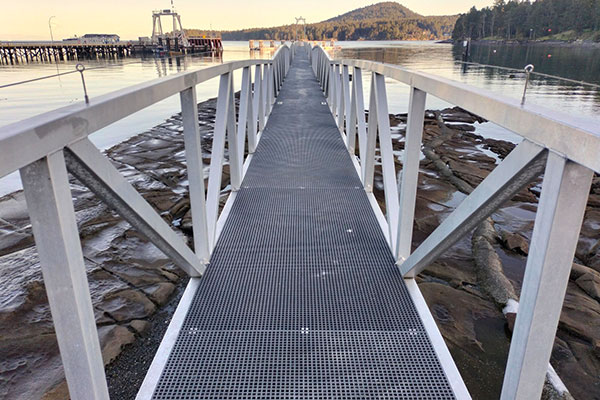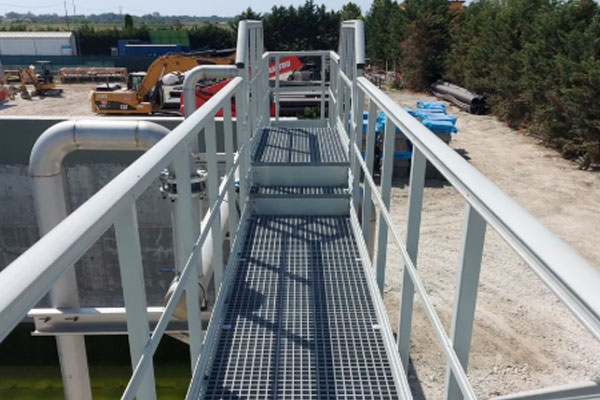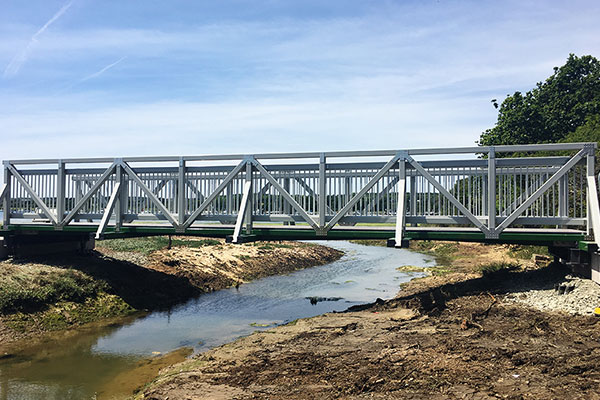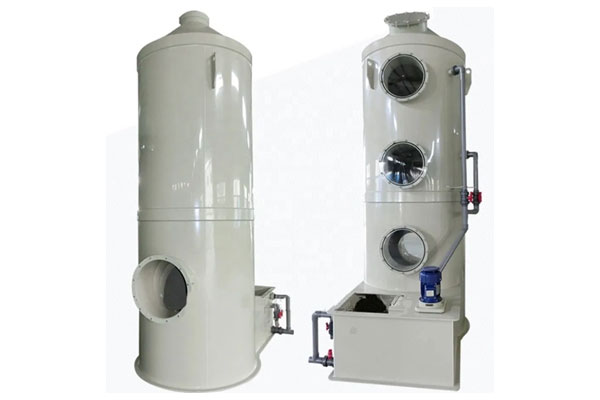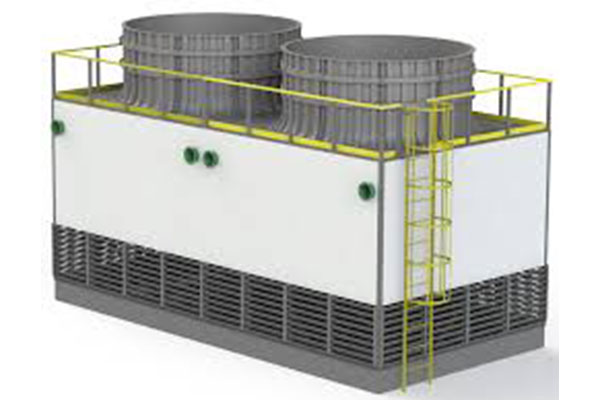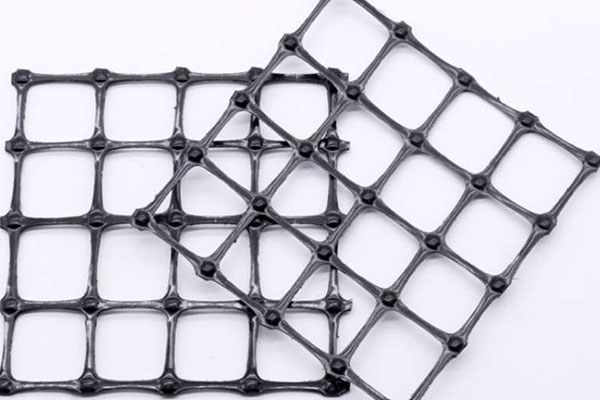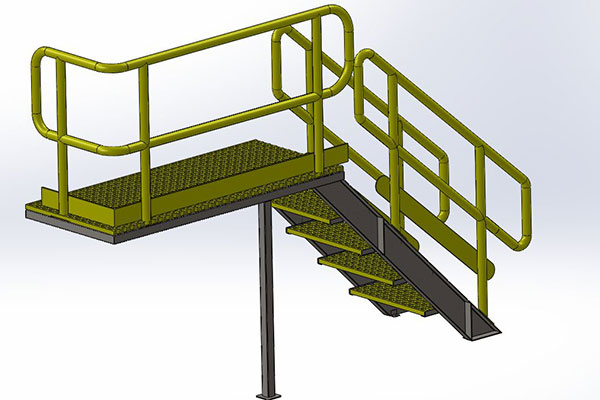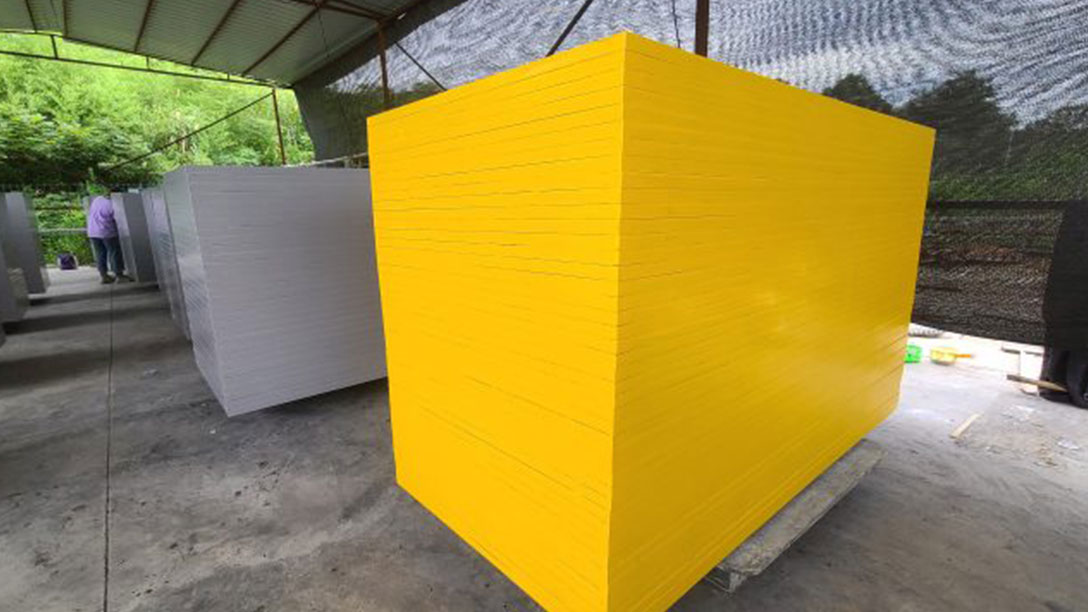Glass Fiber Reinforced Plastic (GFRP) bridges are advanced composite structures engineered for pedestrian, vehicular, or utility passage applications. These bridges are fabricated using high-strength glass fibers embedded in a polymer resin matrix, offering exceptional mechanical performance, corrosion resistance, and longevity. GFRP bridges are a modern alternative to traditional materials like steel, concrete, and wood, and are widely used in industrial, coastal, marine, and remote environments due to their lightweight and maintenance-free nature.
การแนะนำประสิทธิภาพของผลิตภัณฑ์
GFRP bridges can be modular or monolithic in design, capable of spanning distances up to 30 meters or more depending on design parameters. Their modularity allows for rapid on-site installation with minimal equipment, making them ideal for projects with challenging logistics or where environmental disruption must be minimized.
2. Key Features
-
ความต้านทานการกัดกร่อน: Immune to corrosion from saltwater, chemicals, and UV exposure, making GFRP ideal for marine and industrial environments.
-
น้ำหนักเบา: Up to 80% lighter than steel, facilitating easy transport and installation.
-
อัตราส่วนความแข็งแรงต่อน้ำหนักสูง: Comparable or superior to structural steel when optimized.
-
ความทนทาน: Resistant to fatigue, moisture, and biological degradation, with a service life of 50+ years.
-
การบำรุงรักษาต่ำ: Requires little to no routine maintenance compared to steel or wood.
-
ที่ไม่นำไฟฟ้า: Ideal for use in areas near electrical equipment or substations.
-
ตัวเลือกสารหน่วงไฟ: Can be engineered to meet Class 1 flame spread rating per ASTM E84.
-
Modular Construction: Enables rapid assembly and disassembly.
3. การสมัคร
-
Pedestrian walkways
-
Cycle bridges
-
Utility support bridges
-
Pipe rack crossings
-
Boardwalks in wetlands or protected zones
-
Industrial plant access
-
Bridge rehabilitation or overlays
4. Typical Configurations
a. Beam and Slab System
-
Main Components: GFRP I-beams or box girders, FRP decking panels
-
Span Length: Up to 20 meters (single span), or longer with multi-span systems
-
Support Types: Piers, abutments, or existing substructures
b. Truss Bridge System
-
Lightweight triangular truss modules
-
Suitable for long spans (15–40 meters)
-
Often used for pedestrian and pipeline bridges
c. Arch or Cable-Stayed System (Custom)
-
Available for high-end architectural projects
-
Combines aesthetic appeal with high load-bearing capacity
5. Materials and Manufacturing Process
Materials Used:
| Component | วัสดุ | คำอธิบาย |
|---|---|---|
| Fiber Reinforcement | E-glass, ECR-glass | High tensile strength, corrosion-resistant |
| Resin Matrix | Isophthalic Polyester, Vinyl Ester, Epoxy | Chemical resistance, thermal stability |
| Core Material (optional) | PVC foam, Balsa, Honeycomb | Used in sandwich panels for stiffness |
| Gelcoat (Surface Layer) | Polyester-based or UV-resistant formulations | Provides color, UV resistance, and wear protection |
Manufacturing Techniques:
-
Pultrusion (for beams, handrails, profiles)
-
การขึ้นรูปด้วยเรซินถ่ายโอน (RTM)
-
Vacuum Infusion (VARTM)
-
Hand Lay-Up (for customized shapes or reinforcements)
6. Technical Specifications (TDS)
คุณสมบัติทางกล
| คุณสมบัติ | Typical Value | วิธีทดสอบ |
|---|---|---|
| ความต้านแรงดึง | 300–800 MPa | ASTM D638 |
| Tensile Modulus | 20–40 GPa | ASTM D638 |
| ความแข็งแรงในการดัดงอ | 400–900 MPa | ASTM D790 |
| โมดูลัสการดัดงอ | 25–50 GPa | ASTM D790 |
| ความแข็งแรงในการบีบอัด | 200–400 MPa | ASTM D695 |
| ความแข็งแรงในการเฉือน | 70–150 MPa | ASTM D5379 |
| Interlaminar Shear | 40–80 MPa | มาตรฐาน ASTM D2344 |
| Impact Strength (Charpy) | 60–150 kJ/m² | ISO 179 |
| ความแข็งบาร์โคล | 40–60 | ASTM D2583 |
Thermal & Environmental Properties
| คุณสมบัติ | Typical Value | วิธีทดสอบ |
|---|---|---|
| Glass Transition Temperature (Tg) | 80–130°C | DSC, ASTM E1640 |
| ค่าสัมประสิทธิ์การขยายตัวเนื่องจากความร้อน | 8–12 x10⁻⁶ /°C | ASTM E831 |
| Operating Temperature | -40°C to +100°C (standard resins) | - |
| ต้านทานรังสียูวี | Excellent (with protective coating) | ASTM G154 |
| Moisture Absorption | <0.2% | ASTM D570 |
Fire Performance (Optional Fire-Retardant Systems)
| คุณสมบัติ | Typical Value | วิธีทดสอบ |
|---|---|---|
| Flame Spread Index | <25 (Class I) | ASTM E84 |
| Smoke Density | <450 | ASTM E662 |
| Ignition Temperature | >350°C | ASTM D1929 |
7. Structural Design Considerations
GFRP bridge design follows a combination of international standards such as:
-
ACI 440.1R – Guide for the Design and Construction of GFRP Reinforced Concrete
-
Eurocomp Design Code
-
ASTM D7290 – Standard Practice for Evaluating Material Property Characteristic Values
-
ISO 527 – Plastics—Determination of tensile properties
-
FIB bulletin 40 – FRP reinforcement in concrete structures
Designs typically consider:
-
Dead load and live load (AASHTO or Eurocode)
-
Wind load, snow load, and seismic considerations
-
Deflection limits (L/300 for live load)
-
Creep and fatigue behavior under sustained loads
-
Long-term environmental exposure
Finite Element Modeling (FEM) is often used to simulate performance and verify structural integrity under expected service conditions.
8. Assembly and Installation
GFRP bridges are prefabricated at the factory and shipped in modules or as complete spans. Installation is quick and does not require heavy lifting equipment due to the lightweight properties.
ขั้นตอนการติดตั้ง:
-
Prepare foundations or abutments
-
Position main support beams or truss sections
-
Install decking panels and fasten with corrosion-resistant bolts or adhesives
-
Mount railings and accessories
-
Perform inspection and testing
Advantages in Installation:
-
Can be installed in hours instead of days
-
No welding or hot works on site
-
Minimal disruption to the environment
-
Easily replaceable components
9. Surface Finish and Aesthetic Options
-
Anti-slip top layers (abrasive grit or embedded silica)
-
Color customization via pigmented gelcoats (grey, yellow, green, custom RAL)
-
UV-resistant topcoats
-
Embedded signage or safety lines
-
Optional natural wood-look texture for park or trail use
10. Environmental and Sustainability Benefits
-
Low Carbon Footprint: Lower embodied energy than concrete and steel over lifecycle
-
Recyclability: Thermoset GFRP can be downcycled for fillers; thermoplastic GFRP is recyclable
-
Long Life Cycle: Reduced replacement and maintenance cycles
-
Minimal Site Disruption: No heavy excavation or long-term closure of ecosystems
11. Compliance & Certification
GFRP bridge systems comply with or can be engineered to meet the following certifications:
-
ASTM D638, D790, D695, D2344
-
ACI 440 design recommendations
-
EN 13706 (Pultruded profiles)
-
ISO 9001:2015 (Quality management)
-
CE marking (for EU projects)
-
Fire performance certification (as required)
-
Load testing certification (performed during factory QA)
12. Maintenance and Inspection Guidelines
While GFRP bridges are considered “maintenance-free,” the following periodic checks are recommended:
-
Visual inspection every 1–2 years
-
Checking of bolts and fasteners for tightness
-
Cleaning of surface grit and debris
-
Reapplication of anti-slip coatings after 10+ years (if needed)
-
Re-coating of gelcoat (optional) for aesthetic purposes after 15–20 years
13. Case Studies & Applications
Case 1: Pedestrian Bridge Over Coastal Wetland, USA
-
15-meter truss bridge
-
Installed in a protected ecological area
-
Required zero heavy machinery
-
Finished in under 2 days
Case 2: Utility Access Bridge, Chemical Plant, Europe
-
30-meter beam-and-deck span
-
Resistant to acid fumes
-
Installed over existing concrete piers
Case 3: GFRP Replacement Decking, Historical Bridge
-
Existing steel structure retained
-
GFRP deck panels used for fast retrofitting
-
Reduced dead load by 60%
14. Packaging and Shipping
-
Bridge modules and components are wrapped in protective film
-
Standard ISO containers or flatbed trailers used for transport
-
All parts are numbered and accompanied by detailed installation manuals
-
Storage should be done on flat, dry surfaces with cover from UV exposure prior to installation
15. Ordering Information
When ordering a GFRP bridge, provide the following:
-
Required span and width
-
Load requirements (pedestrian, light vehicle, utility)
-
Site conditions (marine, industrial, rural, etc.)
-
Foundation type or available substructure
-
Color and finish preferences
-
Fire rating (if needed)
-
Accessories: railings, lighting, anti-slip coating
16. Warranty and Support
-
Standard warranty: 25 years structural integrity
-
Optional extended warranty programs available
-
Technical support includes:
-
Pre-design consulting
-
Custom drawings
-
Site installation guidance
-
Load test reports (on request)
-
Glass Fiber Reinforced Plastic (GFRP) Bridge
ชุด :
สินค้า >แอปพลิเคชัน
A GFRP bridge is a structural system made primarily from Glass Fiber Reinforced Plastic, a composite material that combines glass fibers and a polymer resin matrix. It is designed to offer high strength, lightweight, and exceptional resistance to corrosion, especially in environments where steel or concrete would degrade.
ชื่อแบรนด์ :
ทีเอฟคอมโพสิต
ชื่อผลิตภัณฑ์ :
Glass Fiber Reinforced Plastic (GFRP) Bridge
คำถามที่พบบ่อย
ถาม :
What are the advantages of GFRP bridges compared to traditional materials like steel or concrete?
ตอบ :
Corrosion Resistance – No rust, even in marine or chemical environments Lightweight – 50–80% lighter than steel, making transport and installation easier Long Service Life – 50+ years with minimal maintenance High Strength-to-Weight Ratio Non-conductive and Non-magnetic – Ideal for electrical infrastructure Low Maintenance – No painting or recoating needed
ถาม :
What types of GFRP bridges are available?
ตอบ :
Pedestrian Bridges Vehicular Access Bridges (light vehicles) Utility Bridges (pipes, cables) Temporary/Portable Bridges Modular Panel Bridges
ถาม :
Are GFRP bridges strong enough to handle heavy loads?
ตอบ :
Yes, GFRP bridges are designed according to international standards (e.g., ACI, ASTM, Eurocomp) to meet or exceed load-bearing requirements. For vehicular traffic, customized GFRP components are engineered to meet live load criteria like AASHTO H-20 or HS-25.
ถาม :
How are GFRP bridges installed?
ตอบ :
Prefabricated offsite for rapid deployment Delivered in modular sections or full spans Installed using cranes or lightweight machinery No welding – Typically bolted or adhesively bonded connections
ถาม :
How do GFRP bridges perform in harsh environments (e.g., coastal, chemical, desert)?
ตอบ :
GFRP is immune to corrosion, UV stable, and chemically resistant, making it ideal for: Saltwater exposure Acidic or alkaline runoff High-humidity tropical zones Extreme cold or heat
ถาม :
Are GFRP bridges fire-resistant?
ตอบ :
GFRP has limited fire resistance, but fire-retardant resins and intumescent coatings can be applied to meet safety codes. Fire rating depends on the project and regional regulations.
ถาม :
What maintenance is required for a GFRP bridge?
ตอบ :
Visual inspections every 1–2 years Reapplication of anti-slip coatings every 10+ years if required No corrosion treatment, painting, or sealing needed Minimal wear due to inert materials
ถาม :
Are GFRP bridges approved by regulatory authorities?
ตอบ :
Yes. Many systems are designed to comply with: ASTM standards (D3039, D790, D7290) ACI 440 guidelines ISO 9001:2015-certified manufacturing National transportation or infrastructure agency approvals
ถาม :
Can GFRP bridges be customized in terms of appearance?
ตอบ :
Custom colors via gel coats or embedded pigments Textured surfaces (wood grain, anti-slip) Architectural shaping and curves
สินค้าอื่นๆที่เกี่ยวข้อง

